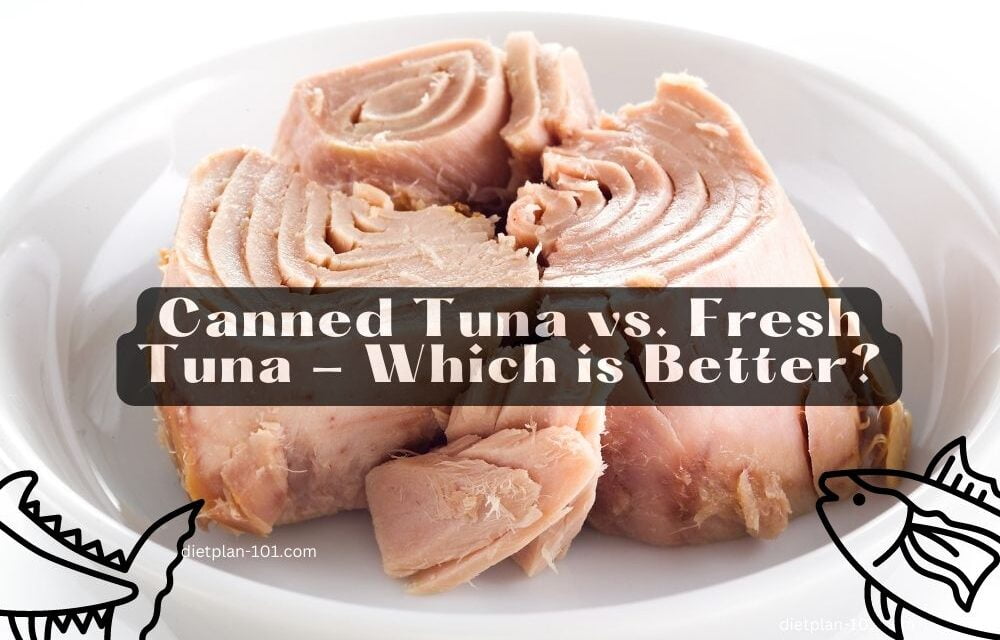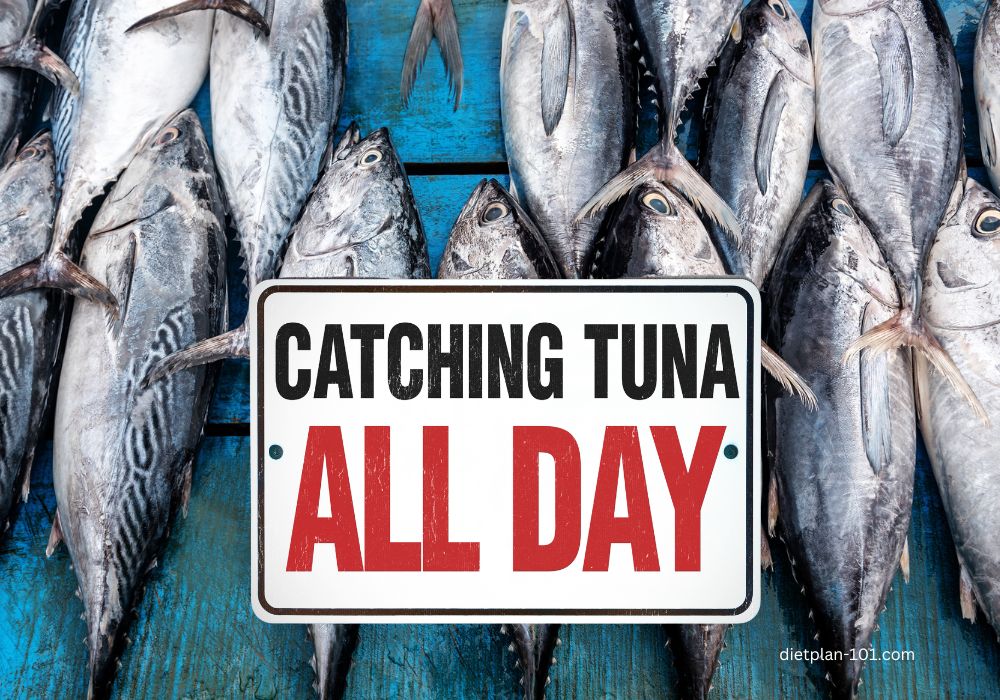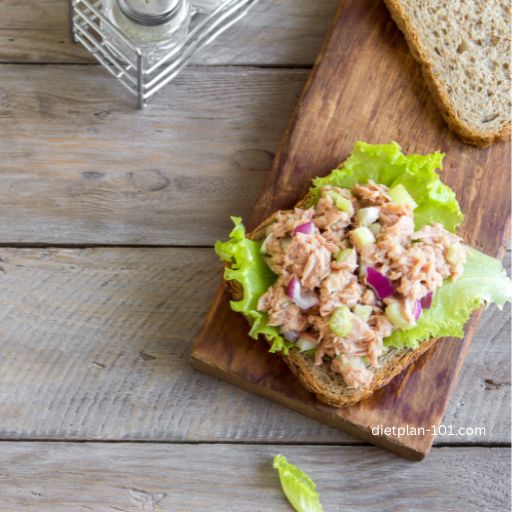Introduction
Many prefer tuna as their go-to seafood. However, when it comes to purchasing it, the dilemma is whether to choose fresh or canned. While both options are tasty, there are some noteworthy contrasts to consider.
We’ll explore the nutritional differences, safety considerations, environmental impact, and cost and convenience factors between canned and fresh tuna. We’ll also provide some fun facts about tuna and delicious recipes to try at home.
Nutritional Differences Between Canned and Fresh Tuna
Tuna, oh tuna, how we love thee! This popular seafood is enjoyed by people all around the world. Not only is it delicious, but it’s also an excellent source of protein, omega-3 fatty acids, and other important nutrients. However, are you a canned tuna person or a fresh tuna person? Let’s dive in and explore the differences.
Canned tuna is often packed in either oil or water. Oil-packed tuna tends to be more flavorful, while water-packed tuna is lower in calories and fat.
First up, canned tuna. You’ve got two choices here: packed in oil or packed in water. If you’re feeling fancy, go for the oil-packed version. It’s higher in calories and fat, but it’s also richer in flavor and totally satisfying. If you’re more of a health nut, opt for the water-packed version. It’s lower in calories and saturated fat but still jam-packed with all the good stuff.
Let’s now discuss fresh tuna. It costs more, but it’s so worth it. Fresh tuna has a softer flavor and less sodium than its canned cousin, making it the ideal choice for people who don’t want their taste senses to be overpowered. Moreover, you can bake, roast, barbecue, or add it to a salad. There are countless options!
Both canned and fresh tuna are winners in terms of nutrients. They are stuffed with of essential nutrients including omega-3 fatty acids, protein, and other things. Fresh tuna has a maximum protein content of 30 grams per serving, compared to up to 40 grams in cans of tuna. Moreover, omega-3 fatty acids are quite healthy for you. They’ve been shown to reduce inflammation, which is a total win.
But, as with anything, there are some differences to consider. Canned tuna is higher in sodium, which can be a concern for those with high blood pressure. Fresh tuna, on the other hand, is higher in vitamin D, which is important for bone health and immune function.
So, whether you’re a canned tuna fan or a fresh tuna fanatic, both options can be part of a healthy diet. Canned tuna is convenient and affordable, while fresh tuna is a bit fancier and lower in sodium. Just make sure to enjoy it in moderation as part of a balanced diet. Happy eating, friends!
Tuna can swim at speeds of up to 60 miles per hour, making it one of the fastest fish in the ocean.
Safety Considerations Canned Tuna vs Fresh Tuna
Hold up folks! Before you go overboard with your love for tuna, there’s something you should know. Tuna can contain mercury, which is a toxic substance that can cause serious health issues if consumed in high amounts. Now, don’t panic just yet. Canned tuna actually has lower levels of mercury than fresh tuna, thanks to the canning process. But, it’s still important to keep an eye on your canned tuna intake and limit it to a few servings per week.
Now, let’s talk fresh tuna. When choosing your fresh catch, go for a smaller type like skipjack or albacore to reduce your mercury exposure. Don’t worry, they’re still just as delicious and packed with all the good stuff. Plus, you’ll feel like a total pro when you order up that perfectly cooked skipjack at your favorite sushi joint.
So, there you have it folks. Tuna is amazing, but we need to be mindful of its mercury content. Stick to a few servings of canned tuna per week and opt for smaller types of fresh tuna to keep things safe and healthy.
Environmental Impact
Did you know that tuna fishing can have a major impact on our environment? Yep, overfishing, bycatch, and destructive fishing practices can seriously harm other marine species and ecosystems. Not cool?
Tuna can be caught using a variety of methods, including pole and line, longline, and purse seine.
But, fear not! Canned tuna to the rescue! It’s often sourced from more sustainable fishing practices like pole and line fishing. So, you can enjoy your tuna salad without any guilt about harming the environment.
Now, let’s talk fresh tuna. When you’re purchasing your fresh catch, make sure you choose a type that’s sustainably sourced. No need to be a marine biologist, just do a quick Google search or ask your fishmonger. And, please, please, please, avoid purchasing from endangered species. We want to keep our oceans healthy and thriving for generations to come.
So, go ahead and indulge in your love for tuna, just make sure you’re doing it in a way that’s kind to our environment. The ocean and all its inhabitants will thank you!
The Pros and Cons of Canned Tuna: Balancing Cost and Convenience with Freshness and Quality
Ah, canned tuna – the ultimate pantry staple! It’s a budget-friendly, convenient option for anyone who wants to stock up on quick and easy meal options. And, let’s be honest, who doesn’t love the classic tuna salad sandwich or a hearty tuna casserole?
But if you’re a seafood connoisseur who loves gourmet dishes and is willing to splurge to buy the best, fresh tuna may be your favorite.
Yes, it’s a bit pricier and can be less convenient, but the taste and texture are unbeatable. Plus, if you’re a stickler for sustainability, purchasing fresh tuna from a reputable source can help ensure it was caught in a responsible and ethical way.
Canned tuna was a staple food for soldiers during World War II and was included in the rations of American soldiers.
Now, let’s talk food safety. It’s important to properly handle and cook fresh tuna to prevent any spoilage or foodborne illnesses. But, with a little care and attention, you’ll be whipping up delicious tuna steaks in no time.
At the end of the day, the selection between canned and fresh tuna is a personal one. It all comes down to what you prioritize – cost and convenience or freshness and quality. So, whether you’re reaching for the can opener or hitting up the seafood counter, make sure you’re making the choice that’s right for you.
| Pros of Canned Tuna | Cons of Canned Tuna |
|---|---|
| Convenient and readily available | May contain added salt or preservatives |
| Cost-effective compared to fresh tuna | Texture and flavor may not be as good as fresh tuna |
| Long shelf life, can be stored for months | Not suitable for all types of dishes, such as sushi or sashimi |
| High in protein and omega-3 fatty acids | May contain lower levels of omega-3 compared to fresh tuna |
| Versatile and can be used in various recipes | May contain traces of mercury and other contaminants |
Canned Tuna Recipe Collection: Tips and Inspiration
Canned tuna is a versatile ingredient that can be used in a variety of dishes.
| Tuna Recipes |
|---|
| Tuna salad sandwich: Mix canned tuna with mayonnaise, diced celery, and diced onion. Spread the mixture on bread, and top with lettuce and sliced tomato. |
| Macaroni Tuna casserole: Cook macaroni according to package instructions. Mix with canned tuna, cream of mushroom soup, frozen peas, broccoli, and shredded cheddar cheese. Bake in a casserole dish at 350°F or 175°C for 25-30 minutes. |
| Tuna and avocado salad: Mix canned tuna with diced avocado, diced cucumber, bell pepper and a vinaigrette dressing. Serve on an avocado half shell. |
| Tuna and white bean salad: Mix canned tuna with white beans, diced red onion, diced cherry tomato, and a lemon vinaigrette dressing. Serve on a bed of arugula or other greens. |
| Pan-fry Tuna patties: Mix canned tuna with breadcrumbs, diced onion, and beaten egg. Form into patties and pan-fry in oil until crispy and golden brown. Serve with tartar sauce or your favorite dipping sauce. |
| Tuna melt wrap: Mix canned tuna with mayonnaise, chopped pickles, and shredded cheddar cheese. Spread the mixture onto a large tortilla, top with lettuce and tomato, and wrap it up. |
| Tuna and corn salad: Mix canned tuna with canned corn, diced red onion, chopped cilantro, and a lime vinaigrette dressing. Serve on a bed of spinach or other greens. |
| Tuna and vegetable stir-fry: Sauté sliced vegetables like bell peppers, zucchini, and mushrooms in oil until tender. Add canned tuna and stir until heated through. Sprinkle sesame seeds on top before serving for added texture. Serve over rice. |
| Tuna and quinoa bowl: Mix canned tuna with cooked quinoa, diced avocado, cherry tomatoes, and a drizzle of balsamic vinaigrette. Top with chopped nuts or seeds for added crunch. |
| Tuna egg salad sandwich: Mix canned tuna with chopped hard-boiled eggs, mayonnaise, diced celery, and a squeeze of lemon juice. Serve on whole-grain bread or in lettuce cups. |
Here are some tips for working with canned tuna:
- Drain the tuna before using it in your recipe to remove excess moisture and prevent your dish from becoming too watery.
- If you prefer a milder taste, use canned tuna packed in water rather than oil.
- Experiment with different varieties of canned tuna, such as solid white tuna or flavored varieties like lemon pepper or jalapeño.
- Add canned tuna to your favorite dishes for a quick and easy source of protein. It pairs well with pasta, rice, potatoes, and many vegetables.
The Bottom Line
When it comes to canned tuna vs. fresh tuna, both options have their pros and cons. It ultimately depends on personal preference and lifestyle factors. Consider the nutritional value, safety considerations, environmental impact, and cost and convenience factors before making your decision. Remember to enjoy tuna in moderation and choose sustainable options when possible.
Canned tuna FAQs:
Is canned tuna safe to eat?
Yes, canned tuna is generally considered safe to eat. It undergoes a sterilization process during canning that helps to prevent bacterial growth. However, it’s important to follow proper storage and handling guidelines to ensure its safety.
How should I store canned tuna?
Unopened cans of tuna can be stored in a cool, dry place such as a pantry. Once opened, the tuna should be transferred to a covered container and stored in the refrigerator for up to three days.
Can I substitute canned tuna for fresh tuna in recipes?
Yes, canned tuna can be substituted for fresh tuna in many recipes. It’s a convenient and affordable option for adding protein to meals.
How much canned tuna can I safely consume per week?
The FDA recommends that adults consume no more than two to three servings of canned tuna per week due to potential mercury exposure.
What are the different types of canned tuna and which one should I choose?
The two main types of canned tuna are albacore (also known as white tuna) and skipjack (also known as light tuna). Albacore tuna has a milder flavor and higher mercury content, while skipjack tuna is more commonly used in canned tuna products due to its lower mercury content. It’s a matter of personal preference which one to choose.
Can I eat canned tuna if I’m pregnant or breastfeeding?
Pregnant and breastfeeding women should limit their consumption of canned tuna due to potential mercury exposure. The FDA recommends that these women consume no more than one serving of canned tuna per week.
Can I eat canned tuna if I have a seafood allergy?
If you have a seafood allergy, you should avoid canned tuna or any other seafood products.
Are there any health benefits to eating canned tuna?
Canned tuna is a good source of protein, omega-3 fatty acids, and vitamins and minerals such as vitamin D, selenium, and B12.
How can I make canned tuna taste better in my meals?
You can add flavor to canned tuna by mixing it with ingredients like mayonnaise, mustard, herbs, and spices. You can also use it as a protein source in dishes like casseroles, salads, and sandwiches.
Is canned tuna safe for dogs to eat?
Canned tuna is generally safe for dogs to eat in moderation. However, it should not be fed as a main source of protein as it may not contain all the nutrients that dogs need.
Is canned tuna safe for cats to eat?
Canned tuna is safe for cats to eat in moderation, but it should not be fed as a main source of protein as it may not contain all the nutrients that cats need.
How long does canned tuna last in the fridge once it’s opened?
Once opened, canned tuna should be stored in the refrigerator and consumed within three days.
What are some creative ways to use canned tuna in recipes?
In addition to the recipes listed above, canned tuna can be used in pasta dishes, sushi rolls, and as a topping for salads and pizzas.
How does canned tuna compare to other types of canned fish in terms of nutrition and taste?
Canned tuna is a good source of protein and omega-3 fatty acids. Other canned fish such as salmon and sardines also provide similar health benefits. In terms of taste, canned tuna has a mild flavor that pairs well with a variety of ingredients.
Are there any risks associated with consuming too much canned tuna?
Consuming too much canned tuna can lead to an accumulation of mercury in the body, which can cause health problems over time. It’s recommended to limit canned tuna consumption to 2-3 servings per week for adults, and less for children and pregnant women.
Which is better tuna in oil or water?
Canned tuna packed in water is generally considered to be healthier than canned tuna packed in oil, as it is lower in calories and fat. However, canned tuna packed in oil can be a good source of heart-healthy monounsaturated and polyunsaturated fats, as long as it is consumed in moderation.



















